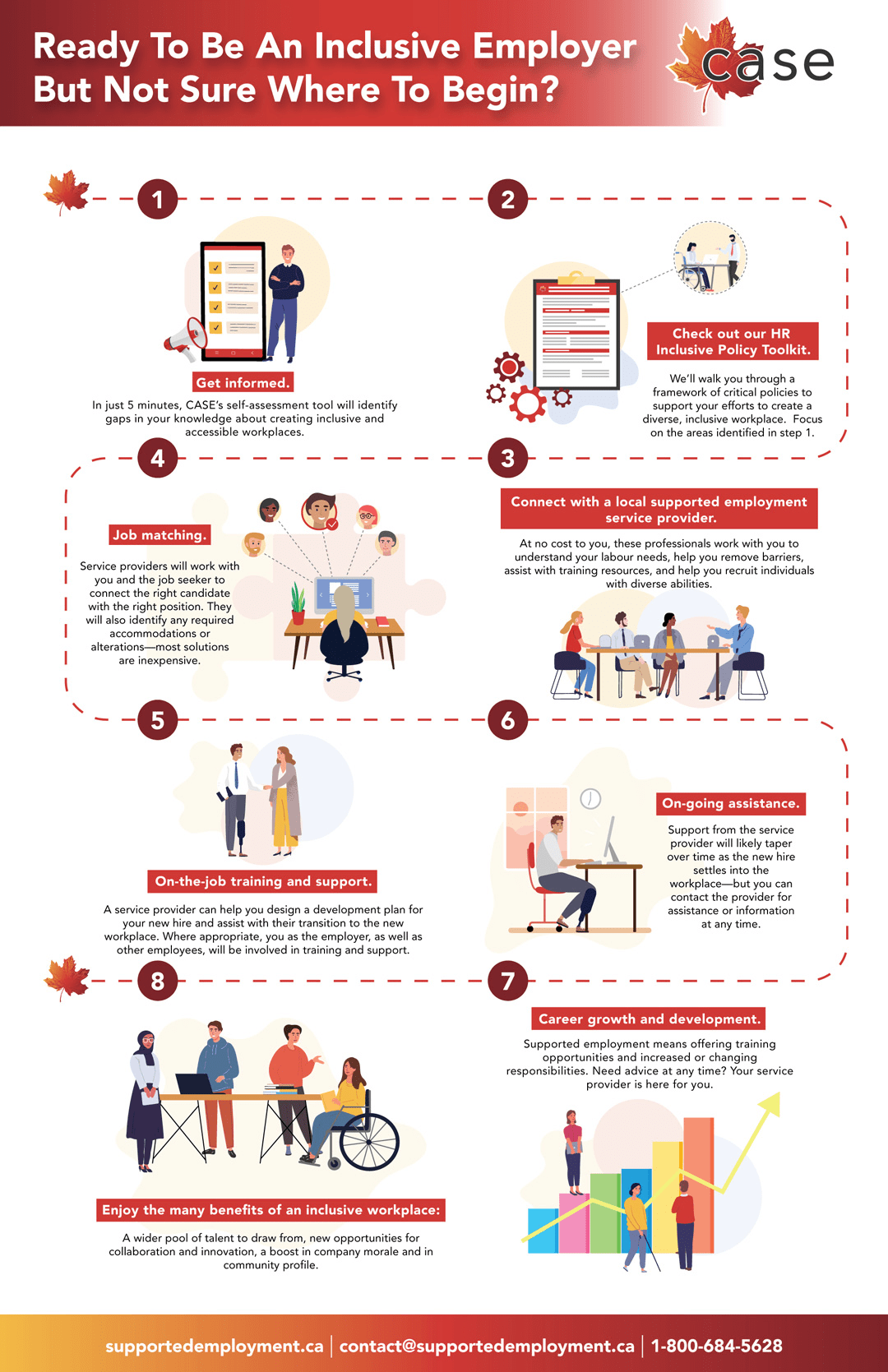Employment Planning Hub
Employer Resources
Disability is Diversity
It is our intention to provide employers with information, tools and strategies to increase their confidence and ability to recruit, train and retain employees with disabilities. People with disabilities experience some real barriers to acquiring employment. This is typically an issue of inaccessibility. Our recruitment systems and practices – not to mention our misunderstanding of disability – often create barriers which keep people with disabilities out of the workforce.
Why Hire a Person with a Disability?
There are two simple reasons for employers to actively recruit and retain employees with disabilities:
- They can do the job. For the same reason you would hire anyone; because you’ve met them and you’re reasonably convinced that they can do the job and that they’ll stay in the position for the foreseeable future. You might also believe that they’ll be a good addition to your workplace culture.
- Disability is diversity. Addressing diversity and inclusion has become a survival strategy for Canadian businesses as 25% of our workforce prepares to retire over the next 10-15 years. Canada’s low birth rate means that the workers who will replace those who leave will increasingly come from ‘diversity groups’ or from younger generations who statistically care more about diversity and inclusion. Workers with disabilities help employers improve their ability to attract, engage and retain workers from diversity groups.
What Does the Research Say?
The research supports that the benefits of hiring workers with a disability include:
- Lower employee turnover rates
- Improved employee engagement and workplace morale
- Improved workplace safety
- Performance, innovation and profits
- Attract and retain other diversity groups
- Improved market representation and company image
- People with disabilities have often gone through more extensive career exploration in order to identify the jobs in which they are most interested and able to perform.
- There are often community-based service providers involved who can also assist employers with recruitment, training and retention – which translates to free workplace diversity and inclusion coaching for your business.
- It is important to note that these benefits will only be realized if the person is, in fact, a good fit for the job.
Disability is the fastest growing minority group – with close to 20% of Canadians identifying as having some type of disability.
Making Your Workplace Accessible
Although physical accessibility of your workspace may be an issue for some job seekers – that is not our only focus here. We would like to draw your attention to employment accessibility and employee recruitment.
What are the processes involved in getting a job at your company?
What matters most to you with regard to new employees?
What can be done to make sure that you have access to the best people for the job (without accidentally screening them out)?
Standard recruitment practices involve job postings, an application process that often relies on Applicant Tracking Systems (ATS) which screen out the majority of applicants. Recruitment practices are, in general, a system of exclusion. Employers (or designated HR people) receive many resumes and applications but they only have time for a few interviews, so most applicants are excluded. The problem with this system is that we’re looking for the best talent for the job – not the best ATS navigators, resume writers and interviewees.
Employment Accessibility and Inclusive Recruitment Strategies Employers Can Use
Inclusive Job Postings – Simply state that your company welcomes applications from people with employment accessibility barriers and that such applicants may contact the designated hiring lead directly via email or phone. This can help mitigate electronic application barriers.
Candidate Representation – Some candidates with disabilities may be using some type of professional or family-based support to apply for work and help them through the interview process. Although this may seem irregular to some employers, this type of support will help you to better assess the ability of the candidate and ‘fit’ for available positions. Allow third-party representation.
Interview Alternatives – Some candidates may have self-confidence or communication difficulties which interfere with successful interviewing. Third-party representatives may ask for some consideration or accommodation around attending the interview as communication support – or allowing for alternatives such as a video interview or even a job trial to demonstrate skills and abilities directly. Consider granting alternatives to your usual recruitment processes to explore candidate talents in new ways.
Training and Onboarding
The single biggest factor in employment retention is training. Effective orientation and training helps employees develop realistic expectations, positive attitudes, and job satisfaction. It also reduces employee turnover and saves supervisor time over the long run.
On-the-Job-Training (OJT)
On-the-Job-Training (OJT) utilizes existing workplace resources including:
- Co-workers and mentors
- Policies and procedures
- Documents, manuals and videos
It is important to note that the most competent trainers are managers and employees who know the people, routines and culture of the company. In some cases, it can be of benefit for the employer to access some on-the-job training supports which help with the training process in cases where significant time or disability-based expertise is required. This may be a required accommodation for the person to effectively learn the job – and there are free, third-party supports available to assist with this type of enhanced on-the-job training.
Training and Orientation Plans
Developing training and orientation plans that outline job expectations and performance measures are beneficial to the employees and employers. Clearly documenting the orientation and training process can help improve employee retention rates, engagement and productivity, as well as the strategies, tools and people that will be utilized to orient and train the new employee. This is a true ‘bottom line’ tactic that will improve employee retention, engagement and productivity. It’s also a basic best practice in onboarding for all new employees.
Workplace Learning
A large amount of workplace learning occurs through conversations and interactions at work – this is why social inclusion is so important. Assigned mentors are a best practice for any employment orientation or training scenario – as are regular opportunities for the new employee to get feedback about their performance and ask questions. This practice benefits any workplace.
Workplace Inclusion Resources
Below are some current resources for employers to improve their confidence and capacity to include workers with disabilities and create a more sustainable, inclusive workforce.
Canadian Association for Supported Employment

Ontario Disability Employment Network – Business Resources
Hiring Persons with Disabilities, Inclusive Workplaces are Good for Business, Government of Canada
4 Ways to Improve Your Company’s Disability-Inclusion Practices, Harvard Business Review
Real-Eyes Capacity Consultants, National Diversity and Inclusion Consultants


